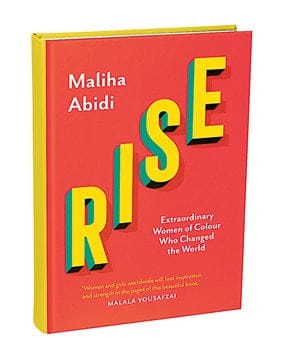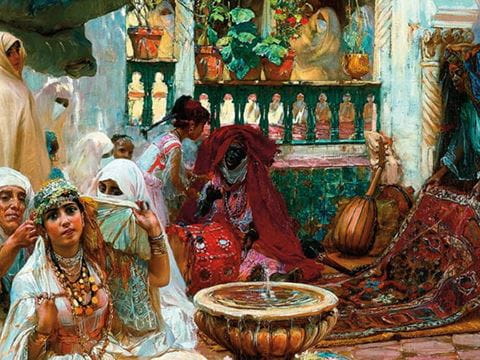
How Maliha Abidi Paints Stories of Pakistani Women's Strength
After growing up in Karachi, Pakistan, and moving to California as a teenager, artist and author Maliha Abidi found it difficult to find stories of women who looked like her or with whom she felt she could identify.
After growing up in Karachi, Pakistan, and moving to California as a teenager, artist and author Maliha Abidi found it difficult to find stories of women who looked like her or with whom she felt she could identify.
In 2019, Abidi, then 23 and living in the United Kingdom after getting married, decided to remedy this, publishing her first book, Pakistan for Women. Featuring profiles of 50 Pakistani women, Abidi, a multidisciplinary artist, created colorful portraits for each subject using pencils, acrylics, markers and other media.
Two years later, Abidi followed up with Rise, sharing the lives of 100 women from more than 30 countries. “At the end of the day,” explains Abidi, “my work is trying to celebrate and share a moment of joy when it comes to Brown identity.”
AramcoWorld recently chatted with Abidi about how her books have impacted her as an artist and a Muslim woman.

Rise: Extraordinary Women of Colour Who Changed the World Maliha Abidi. Saqi Books, 2021.
What motivated you to write your first book?
I was living with my husband in Crawley, England. In our local bookstore I discovered books about women from around the world, including Rebel Girls, a series by Elena Favilli. It was exciting to find books that introduced me to so many incredible women, but I rarely found someone who looked like me in those books. There were few stories about Muslim women, and there were very few, if any, narratives about inspiring Pakistani women.
My other inspiration was my own life. When I moved from Karachi to California at 14, I was exposed to preconceived notions about Pakistani girls and women. I wore a headscarf to school, and one of my teachers was surprised when he discovered I rode a bike. He clearly didn’t think a Pakistani girl was allowed to do that. Recalling my own experiences, I decided to challenge these misperceptions by writing about remarkable Pakistani women using my art and research.
What made you decide to expand your stories to include women outside of Pakistan with Rise?
With my second book, initially we were going to focus on Muslim women, but my publisher and I decided it was important to celebrate women of color from around the world. That was the easy part. It was much harder to narrow it down to 100 names. Then it was even more difficult to draw the portraits. There are 100 stories and portraits in the book, but I created at least 220 portraits. With each one I was always worried whether I had really captured the spirit of these incredible women. But in the end, those two years of hard work helped me grow a lot as an artist.
Pakistan for Women received international acclaim and led to interviews with the British Broadcast Company, the United States morning show, Good Morning America, and other media outlets. What was the general response to the book?
It was very positive, both from readers and from the women I profiled. The best compliment I’ve received, one that I will always remember, came from a 14-year-old girl who was born and raised in Australia with a Pakistani background. She wrote that she never wanted to tell people where her family came from because of the way her country is portrayed in the news. When her father was traveling to Pakistan, she asked him to get her a copy of Pakistan for Women. After reading the book, she told me that she now had something to be proud of. That was very heartwarming for me.
What impact have these books had on you as an author, an artist and as a Muslim woman?
I learned a lot. In terms of my identity as a Muslim woman, I was raised by a very cool Pakistani dad who never limited me. I have always felt very liberated and confident. But throughout the process of working on these books, I learned so much about Muslim feminism from the women I profiled. It increased my understanding of world politics and how gender is viewed in different parts of the world.
I also became a better artist, because working on the illustrations pushed the limits of my creativity. In general, I feel like working on these books has made me a more curious person, a more curious learner. These books have allowed me to live my dream and continue to open so many doors for me as a researcher and an artist.
This interview has been lightly edited and condensed for length and clarity.
You may also be interested in...

Artists Answer COVID-19
Arts
Amid this year’s travel bans, museum and gallery closures, lockdowns, quarantines, and social distancing, visual artists are responding with fresh imagery and creative collaborations across new platforms to articulate this moment and carry culture forward into the next.
How Mohamed Shafik Gabr Redefines Orientalism
Arts
In 1884, a 23-year-old painter named Étienne Dinet took a break from Paris to travel to Algeria, where he became a prominent Orientalist artist—a European depicting scenes of cultures not his own. In the 1990s, art collector Shafik Gabr noticed that Dinet stood out among a number of Orientalists whom Gabr says approached their work as an “art of face-to-face engagement between East and West.” Gabr credits Dinet and other “respectful observers” with the inspiration to inaugurate East-West: The Art of Dialogue, an annual intercultural encounter program for emerging leaders.
How Historical Paintings of Taj Mahal Changed Perceptions of India
Arts
History
The depiction of the Taj Mahal in the works of Indian and British artists in the 1800s helped bolster enthusiasm for the country & rsquo;s rich culture, architecture and society. One such painting, & ldquo; The Taj Mahal by moonlight,& rdquo; stirred a bidding frenzy at a recent auction, and some experts argue that such paintings have helped change perceptions of India in the West.